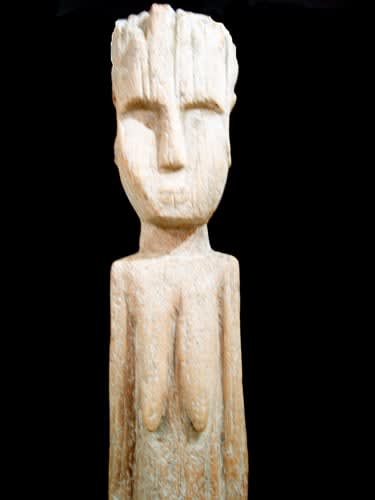Belanda Female Figure, 1800 CE - 1900 CE
Wood
88
BONGO.901 (LSO)
This powerful, elongated sculpture is a funerary marker made by the Belanda people of Southern Sudan. It comprises a columnar post supporting a tall, slender female figure with long, delicate...
This powerful, elongated sculpture is a funerary marker made by the Belanda people of Southern Sudan. It comprises a columnar post supporting a tall, slender female figure with long, delicate limbs. The head is blocky and austere, with a T-bar brows and nose complex. Detailing is minimal, which adds to the impact of the piece. The indents towards the bottom of the support are likely to pertain to something achieved by the deceased person; given that she is female, it may refer to the number of male children she had.
The Belanda are one of several closely affiliated groups (Bongo, Belanda, Sara) that moved from Chad in the 16th century to the grasslands area of southern Sudan. They are especially known for their grave markers – tall posts with anthropomorphic features – carved from mahogany which resists weathering and termites. The posts are awarded to worthy people, such as chiefs. Some examples bear specifics about the interred individual, such as notches that denote the number of large animals they killed. The posts become a focal point through which living descendants can contact the deceased, whose spirit will be with Loma (the creator god).
The Bongo only honour males in this way, although the Belanda also put them up to women. The physical features are idealised, not portraits of the deceased. When buried, the flamboyance of the festivities must match the worthiness of the deceased, or else he will be unable to use his influence with Loma to improve the lot of his descendants. The posts were buried deeply into the burial mounds of prominent personages, and, if removed, were cut off about half way up to prevent damaging the sacred ground. The large posts are usually surrounded by a host of smaller figures that represent family members. Other artworks are associated with the altars hunters raise to Loma-Gubu, the antithesis of Loma, who must be appeased by appropriate behaviour from the hunter and his wife.
Belanda works can be differentiated from Bongo posts by the more realistic and figurative appearance of the former. This is a beautifully harmonious and well-carved piece of African art, and a credit to any good collection or sophisticated domestic setting.
The Belanda are one of several closely affiliated groups (Bongo, Belanda, Sara) that moved from Chad in the 16th century to the grasslands area of southern Sudan. They are especially known for their grave markers – tall posts with anthropomorphic features – carved from mahogany which resists weathering and termites. The posts are awarded to worthy people, such as chiefs. Some examples bear specifics about the interred individual, such as notches that denote the number of large animals they killed. The posts become a focal point through which living descendants can contact the deceased, whose spirit will be with Loma (the creator god).
The Bongo only honour males in this way, although the Belanda also put them up to women. The physical features are idealised, not portraits of the deceased. When buried, the flamboyance of the festivities must match the worthiness of the deceased, or else he will be unable to use his influence with Loma to improve the lot of his descendants. The posts were buried deeply into the burial mounds of prominent personages, and, if removed, were cut off about half way up to prevent damaging the sacred ground. The large posts are usually surrounded by a host of smaller figures that represent family members. Other artworks are associated with the altars hunters raise to Loma-Gubu, the antithesis of Loma, who must be appeased by appropriate behaviour from the hunter and his wife.
Belanda works can be differentiated from Bongo posts by the more realistic and figurative appearance of the former. This is a beautifully harmonious and well-carved piece of African art, and a credit to any good collection or sophisticated domestic setting.



